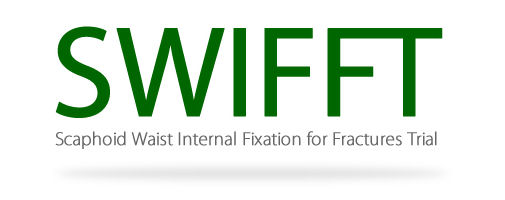SWIFFT: Scaphoid Waist Internal Fixation for Fractures Trial

Welcome to the SWIFFT website.
SWIFFT is a large multi-centre study which compares two ways of treating patients who have broken their scaphoid bone, one of eight small bones in the wrist.
The study started in 2013. It is led by Professor Joseph Dias as the University Hospitals of Leicester NHS Trust and is co-ordinated by researchers at the University of York Trials Unit.
What are scaphoid fractures?
A fracture of the scaphoid is a very common type of wrist injury. It is caused by a fall on the hand or sudden forced twist of the wrist. The treatment of scaphoid fractures is an important public health problem as it affects young active people in their more productive working years.
Patients are usually treated by putting the wrist in a plaster cast for 6 to 10 weeks. This allows the broken scaphoid bone to heal but some do not and then need surgery to fix the bone.
In recent years, doctors have developed another way of holding these fractures in place while they heal. This involves an immediate operation to fix the broken bone with a special screw.
Purpose of this study
We do not know which treatment is better. This large and detailed study will help us find out.
Surgery may restore hand function earlier and avoid the need for a plaster cast for 6 to 10 weeks. There are risks associated with having an operation, such as infection, bleeding or stiffness.
In recent years there has been a rapid increase in the rate of surgery for this type of fracture (rising from 37% in 2007/8 to 62% in 2009/10). This has increased how much the NHS spends to treat this injury, although we lack reliable evidence to back decisions.
One in ten fractures treated in a plaster cast, and a small number of those fixed early, do not heal. If the fracture does not join and is left untreated wrist arthritis develops in most within 5 years.
It is therefore timely that this research, which compares these two methods of treatment, is being undertaken.
We are also investigating the value of the two treatment pathways by investigating cost-effectiveness to inform decisions about treatment for this common fracture in young people.
A unique feature of our study is that, with researchers at the University of Nottingham, we will explore patient’s views and experiences of their wrist injury, as well as their views on taking part in surgical trials.
Researchers at the University of Leicester and the University of York Trials Unit will work together on analysis of the information we collect.
Privacy Notice: How we use your research data
SWIFFT Publications
Contact Us
Please contact Dr Stephen Brealey (Trial Manager) email stephen.brealey@york.ac.uk or call 01904 321357 if you have any enquires about the study.
In collaboration with
![]()
![]()

In partnership with
.jpg)

